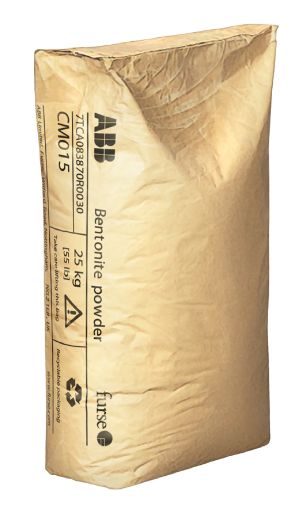CM015 Bentonite is a sodium-activated montmorillonite that swells to many times its dry volume when mixed with water. This enables moisture to be absorbed from the surrounding soil (e.g., rainfall), solving soil-to-earth rod contact problems.
Features & Benefits
- Maximised surface. Swells up to thirteen times its dry volume, greatly improving contact resistance.
- Non-corrosive. Protects the electrode and does not change characteristics as time elapses.
- Low resistivity. Bentonite’s installed resistivity varies from about 3 Ohm metres upwards, depending on its moisture content.
Application
Bentonite moisture-retaining clay is commonly used as a backfill for earth rods installed in drilled holes or as a layer encapsulating horizontal earth conductors buried in a trench. Its main advantage in earthing is that it can retain moisture near an earth rod and hold it there for a considerable period. This reduces contact resistance and increases the effective size of earth electrodes.
When used as a backfill for an earth electrode, Bentonite reduces its resistance to the earth by greatly increasing the electrode’s surface electrode, improving its contact with the surrounding soil. For example, increasing a rod’s effective diameter from 15 mm to 200 mm (in Bentonite) could lower its resistance to the earth by as much as 40%.
Mixing Procedure
The expansion of Bentonite depends very much on the volume of water with which it is mixed. As a rule of thumb, we assume an expansion ratio of 2:1. So, 1 x 25 kg bag of Bentonite = 1 ft3 (0.0283 m3) of dry or 2 ft3 (0.0566 m3) of wet mixture; therefore, to mix 1 m3 of earth electrode backfill, mix 450 kg (18 bags) of Bentonite with water to suit the application.
Borehole Procedure
- Bore a hole 75 – 100 mm (3-4 inches) in diameter at the desired rod location. The earthing system designer should determine the borehole’s depth.
- Insert the earth rod into the borehole. Ensure that the top of the earth rod is at the correct level for its connection.
- Backfill the borehole with a Bentonite slurry. Regular agitation of the earth rod should ensure that no voids are formed within the backfill.
Trench Procedure
- Dig a trench 200-300 mm (8-12 inches) wide at the desired electrode location. The earthing system designer should determine the depth of the trench (typically 600 mm).
- Cover the bottom of the trench with a stiff mix of Bentonite 25-50 mm (1-2 inches) thick. Lay the earth strip into the trench. Ensure that the strip electrode is not depressed too far into the Bentonite.
- Apply another layer of Bentonite 25-50 mm (1-2 inches) thick. Ensure that the strip electrode is fully covered.
- Carefully backfill and compact the remainder of the trench.

